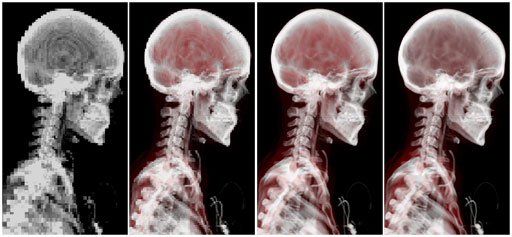
Joel Kronander, Jonas Unger, Torsten Möller and Anders Ynnerman
Linköping University Simon Fraser University
Computer Graphics Forum Vol. 29, No. 3, 2010,
presented at EuroVis 2010

The golden lady data set rendered using (from left to right) 7 bits, 8 bits,
9 bits and 10 bits of precision in the floating point Direct Volume Rendering (DVR) pipeline
Abstract:
In this paper we study the comprehensive effects on volume rendered images due to numerical errors caused by the use of finite precision for data representation and processing. To estimate actual error behavior we conduct a thorough study using a volume renderer implemented with arbitrary floating-point precision. Based on the experimental data we then model the impact of floating-point pipeline precision, sampling frequency and fixed-point input data quantization on the fidelity of rendered images. We introduce three models, an average model, which does not adapt to different data nor varying transfer functions, as well as two adaptive models that take the intricacies of a new data set and transfer function into account by adapting themselves given a few different images rendered. We also test and validate our models based on new data that was not used during our model building.
Keywords: Direct Volume Rendering (DVR), ray casting, floating point precision
Documents:
EuroVis 2010 Paper(.pdf) 1.2 Mb
Acknowledgements:
The authors would like to thank Matt Cooper and Claes Lundström for valuable discussions and proofreading. This work has been supported by the Swedish Research Council under the Linnaeus Center CADICS, and by the Strategic Research Center MOVIII, funded by the Swedish Foundation for Strategic Research, SSF, as well as the Natural Science and Engineering Research Council of Canada.
|
Jonas Unger 2019 |